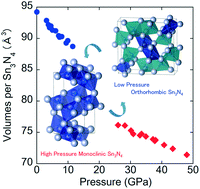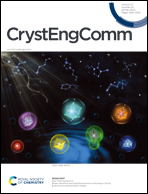Crystal structures and electronic properties of Sn3N4 polymorphs synthesized via high-pressure nitridation of tin†
Abstract
The crystal structures, compression behaviors, and electronic properties of Sn3N4 polymorphs were investigated by means of high-pressure in situ measurements, transmission electron microscopy, and DFT ab initio calculations. The direct nitridation of tin above a pressure of 29.5 GPa by using a laser-heated diamond anvil cell resulted in the synthesis of highly crystalline monoclinic Sn3N4 which so far is consistent with the reported one. On the other hand, it was newly discovered that the monoclinic Sn3N4 undergoes phase transition twice along with decompression at ambient pressure. Advanced synchrotron X-ray powder diffraction measurements and TEM analyses on the recovered sample demonstrate that the newly recovered Sn3N4 crystallizes with orthorhombic symmetry and consists of irregularly shaped SnN5 and SnN6. DFT ab initio calculations reveal that this newly recovered orthorhombic Sn3N4 is an indirect band gap semiconductor having a narrower electronic energy gap than that of cubic spinel-type Sn3N4. The present results demonstrate that high-pressure nitridation is a powerful method to synthesize highly crystalline Sn3N4 polymorphs and reveal the new crystal chemistry of group IVA nitrides with respect to the variety of crystal structures and electronic properties.



 Please wait while we load your content...
Please wait while we load your content...